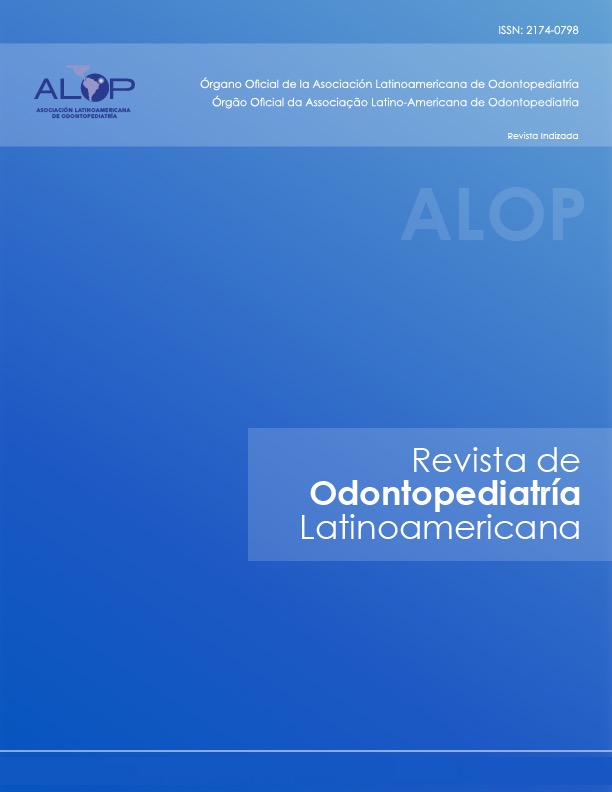Treatment of onycophagia in children: Systematic review
DOI:
https://doi.org/10.47990/alop.v1i1.111Keywords:
children, onychophagia, treatment, psychological therapy, intraoral devicesAbstract
Purpose: To conduct a systematic review to assess and analyze the scientific evidence about the available therapies for finger and nail biting in children. Materials and Methods: The literature was searched using Medline, Pubmed, ovid, EBSCO, ISI, Cochrane Library, Lylacs, Scielo, Scirus and the Internet, published from March 1985 to 2008. The inclusion criteria were: Investigations that treated finger or nail biting with any resource.. The investigations were required to be clinical trials or well done comparative studies. Metanalysis or multicenter studies were considered as well. The children included in the studies required not to have had other type of oral habits and /or neurological diseases and the diagnosis of or nail biting should be performed with anamnesis and other diagnostic tools. Results: From 92 records found, one fulfilled the inclusion criteria. It supports the psychological techniques to treat nail biting in children and do not support intraoral devices or pharmacology with the same objective. Conclusion: Although the selected study accomplished the quality criteria, it is not enough to affirm that treatment of nail biting in children is well supported. Treatment for nailbiting of onycophagia requires further studies.
References
Tanaka OM, Vitral RW, Tanaka GY, Guerrero AP, Camargo ES. Nailbiting, or onychophagia: a special habit. Am J Orthod Dentofacial Orthop. 2008;134:305-308.
Bohne A, Keuthen N, Wilhelm S.Pathologic hairpulling, skin picking, and nail biting.Ann Clin Psychiatry. 2005;17:227232.
Ballinger BR. The prevalence of nail-biting in normal and abnormal populations. Br J Psychiatry. 1970;117:445-446.
Jabr FI.Severe nail deformity. Nail biting may cause multiple adverse conditions.Postgrad Med. 2005; 118:37-38.
Bayda? B, Uslu H, Yavuz I, Ceylan I, Da?suyu IM. Effect of a chronic nail-biting habit on the oral carriage of Enterobacteriaceae. Oral Microbiol Immunol. 2007;22:1-4.
de Berker D. Childhood nail diseases. Dermatol Clin. 2006;24:355-263.
Twohig MP, Woods DW, Marcks BA, Teng EJ. Evaluating the efficacy of habit reversal: comparison with a placebo control. J Clin Psychiatry. 2003 Jan;64:40-48.
Molina OF, dos Santos J, Mazzetto M, Nelson S, Nowlin T, Mainieri ET. Oral jaw behaviors in TMD and bruxism: a comparison study by severity of bruxism.Cranio. 2001;19:114-122.
Lavigne G, Kato T.Usual and unusual orofacial motor activities associated with tooth wear. Int J Prosthodont. 2003;16l:80-82
Owmann-Moll, P; Kurol, J. European Journal of Orthodontics. 2000; 22: 657664.
Chalmers TC, Smith H Jr, Balckburn B, Silverman B.. A method for assessing the quality of a randomized control trial. Control Clin Trials 1981;2:31-49.
Sonis J, Joines J. The quality of clinical trials published in The Journal of Family Practice, 1974-1991. J Fam Pract. 1994;39:225-235.
Bados A, García E, Fusté A. Eficacia y utilidad clínica de la terapia psicológica. Revista internacional de psicología clínica y salud. Int J Clin Health Psychol,2002; 2:477-502.
Scott A. Cognitive behavioural therapy and Young people: An introduction. J Fam Health Care. 2009: 19: 80-82.
Woods DW, Murray LK, Fuqua RW, Seif TA, Boyer LJ, Siah A. Comparing the effectiveness of similar and dissimilar competing responses in evaluating the habit reversal treatment for oral-digital habits in children. J Behav Ther Exp Psychiatry. 1999;30:289-300.
Slade GO, Caplen DJ. Methodological issuas in longitudinal epidemiologic dental caries. Comunity Dent Oral Epidemiol 1999;27:236-248.
Alenen P. Risk in risk definitions. Comunity Dent Oral Epidemiol 1999;27:394.
Navarro Nápoles J, Duharte Escalona A. La lactancia materna y su relación con los hábitos bucales incorrectos. MEDISAN. 2003;7 :17-21
Leonard HL, Lenane MC, Swedo SE, Rettew DC, Rapoport JL. A double-blind comparison of clomipramine and desipramine treatment of severe onychophagia (nail biting). Arch Gen Psychiatry. 1991;48:821-827.
Alexander RC. Fluoxetine treatment of trichotillomania. J Clin Psychiatry. 1991: 34-42
Williams, Larsen Kronenberg, Melmed, Polonsky Trastornos del metabolismo del magnesio. En: Tratado de Endocrinología. 10ª Edición, 2003. pp1458-1459. Barcelona.
Silber KP, Haynes CE. Treating nailbiting: a comparative analysis of mild aversion and competing response therapies. Behav Res Ther. 1992;30:15-22.
Downloads
Published
Issue
Section
License
Copyright (c) 2011 Latin American Pediatric Dentistry Journal

This work is licensed under a Creative Commons Attribution-NonCommercial-ShareAlike 4.0 International License.























